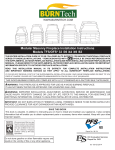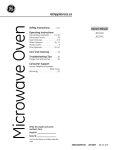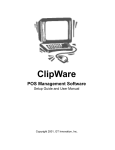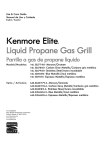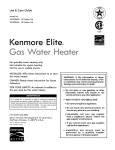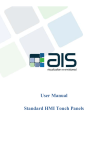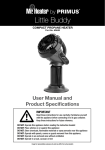Download Burntech BOFP-48P Installation manual
Transcript
FIRE RING MODELS BOFP16-48 AND BOFP24-48 NATURAL GAS BURNER MODELS: BOFP-48NG OWNER’S OPERATION AND INSTALLATION MANUAL PROPANE/LP GAS BURNER MODELS: BOFP-48P TABLE OF CONTENTS Safety...................................................................2 Local Codes.........................................................3 Unpacking............................................................3 Specification.........................................................4 Installation............................................................5 Operation............................................................14 Inspecting Burners..............................................15 Wood Burning……………………………………..17 Cleaning and Maintenance.................................18 Troubleshooting..................................................19 Parts....................................................................22 Service Hints.......................................................25 Technical Service................................................25 Replacement Parts..............................................25 Warranty..............................................................26 SAFETY Solid fuels shall not be burned in this appliance This appliance is only for use with the type of gas indicated on the rating plate. This appliance is not convertible for use with other gas. WARNING: This product contains and/or generates chemicals known to the state of California to cause cancer or birth defects or other reproductive harm. IMPORTANT: Read this owner’s manual carefully and completely before trying to assemble, operate or service this fireplace. Improper use of this fireplace can cause serious injury or death from burns, fire, explosion, electrical shock and carbon monoxide poisoning. DANGER: Carbon monoxide poisoning may lead to death! Carbon Monoxide Poisoning: Early signs of carbon monoxide poisoning resemble the flu, with headaches, dizziness or nausea. If you have these signs, the fireplace may not be working properly. Get fresh air at once! Have fireplace serviced. Some people are more affected by carbon monoxide than others. These include pregnant women, people with heart or lung disease or anemia, those under the influence of alcohol and those at high altitudes. Natural and Propane/LP gases are odorless. An odor-making agent is added to these gases. The odor helps you detect a gas leak. However, the odor added to the gas can fade. Gas may be present even though no odor exists. Make certain you read and understand all warnings. Keep this manual for reference. It is your guide to safe and proper operation of this fireplace. WARNING: Any change to this appliance or its controls can be dangerous. Due to high temperatures, the appliance should be located out of traffic and away from furniture and draperies. Do not place clothing or other flammable material on or near the appliance. Never place any objects on the appliance. Appliance base assembly becomes very hot when running appliance. Keep children and adults away from hot surface to avoid burns or clothing ignition. Appliance will remain hot for a time after shutdown. Allow surface to cool before touching. Carefully supervise young children when they are in the vicinity of the appliance. Keep the appliance area clear and free from combustible materials, gasoline and other flammable vapors and liquids. Do not leave appliance in operation when unattended. 2 SAFETY (Continued) 1. This appliance is only for use with the type of gas indicated on the rating plate. This appliance is not convertible for use with other gases. 2. Do not place propane/LP supply tank(s) inside or under the fire ring. Locate propane/LP supply tank(s) at least 10 feet away (propane/LP units only). 3. If you smell gas • shut off gas supply • do not try to light any appliance • do not touch any electrical switch; do not use any phone in your building • immediately call your gas supplier from a neighbor’s phone. Follow the gas supplier’s instructions • if you cannot reach your gas supplier, call the fire department 4. To prevent the creation of soot, follow the instructions in Cleaning and Maintenance, page 14. 5. Do not run appliance • where flammable liquids or vapors are used or stored • under dusty conditions 6. Do not use this appliance to cook food or burn paper or other objects. 7. Do not use this appliance if any part has been exposed to or under water. Immediately call a qualified service technician to inspect the room appliance and to replace any part of the control system and any gas control which has been under water. 8. Turn appliance off and let cool before servicing, installing or repairing. Only a qualified service person should install, service or repair appliance. 9. This appliances must not be connected to any external electrical source. 10.Operating appliance above elevations of 4,500 feet may cause pilot outage. 17.To prevent performance problems, do not use propane/LP fuel tank of less than 100 lb. capacity (propane/LP units only). 18.Provide adequate clearances around air openings. LOCAL CODES UNPACKING Install and use appliance with care. Follow all local codes. In the absence of local codes, use the latest edition of The National Fuel Gas Code, ANSI Z223.1/NFPA 54*. *Available from: American National Standards Institute, Inc. 1430 Broadway New York, NY 10018 National Fire Protection Association, Inc. Batterymarch Park Quincy, MA 02269 1. Remove burner system and other components from box. Do not grasp by burner tubes. If it is evident that the burner is damaged, it must be replaced prior to being put into operation. Set lava rock boxes aside for further instruction. 2. Remove all protective packaging from pallet of blocks for shipment. 3. Check for any shipping damage. If appliance is damaged call Burntech Fireplace Solutions at 1818-564-4225 for replacement parts before returning to dealer. www.burntech.com 3 SPECIFIATIONS Figure 1 – BOFP16-48 AND BOFP24-48 BOFP-48NG • Rating: 96,000 Btu/hr • Gas Type: Natural Gas Only • Ignition: Manual • Manifold Pressure: 6.0" w.c. • Minimum Inlet Supply Pressure: 7.0" w.c. • Maximum Inlet Supply Pressure: 10.5" w.c. • Orifice: #12 BOFP-48P • Rating: 95,000 Btu/hr • Gas Type: Propane/LP Gas Only • Ignition: Manual • Manifold Pressure: 10.5" w.c. • Minimum Inlet Supply Pressure: 11" w.c. • Maximum Inlet Supply Pressure: 14" w.c. • Orifice: #33 4 INSTALLATION WARNING: A qualified service person must install appliance. Follow all local codes. NOTICE: State or local codes may only allow operation of this appliance in a vented configuration. Check your state or local codes. CHECK GAS TYPE Use the correct type of gas (natural or propane/LP). If your gas supply is not the correct gas type, do not install appliance. Call dealer where you bought appliance for proper type appliance. WARNING: This appliance is equipped for either natural gas or propane/LP gas but not both. Gas type is indicated on the rating plate. Field conversion is not permitted. INSTALLATION AND CLEARANCES WARNING: Maintain the minimum clearances. If you can, provide greater clearances from floor and adjoining wall. MINIMUM CLEARANCE TO COMBUSTIBLE MATERIALS Side Wall 16", Bottom: 0" (For Wood Burning Installation- NonCombustible Floor is Required) WARNING: DO NOT PLACE UNDER A CEILING OR OVERHANG. CONNECTING TO GAS SUPPLY WARNING: This appliance requires a 1/2" NPT (National Pipe Thread) inlet connection to the pressure regulator. WARNING: A qualified service person must connect appliance to gas supply. Follow all local codes. CAUTION: Never connect propane/LP fire ring directly to the propane/LP supply. This appliance requires an external regulator (not supplied). Install the external regulator between the appliance and propane/LP supply. WARNING: Never connect natural gas fire ring to private (non utility) gas wells. This gas is commonly known as wellhead gas. Installation Items Needed Before installing appliance, make sure you have the items listed below. • external regulator (supplied by installer) • piping (check local codes) • sealant (resistant to propane/LP gas) • equipment shutoff valve * • test gauge connection * • sediment trap • tee joint • pipe wrench • approved flexible gas line with gas connector (if allowed by local codes) (not provided) * An equipment shutoff valve with 1/8" NPT tap is an acceptable alternative to test gauge connection. Purchase the optional equipment shutoff valve from your dealer. For propane/LP units, the installer must supply an external regulator. The external regulator will reduce incoming gas pressure. You must reduce incoming gas pressure to between 11" and 14" of water. If you do not reduce incoming gas pressure, appliance regulator damage could occur. Install external regulator with the vent pointing down as shown in Figure 2, page 6. 5 Pointing the vent down protects it from freezing rain or sleet. www.burntech.com INSTALLATION (Continued) CAUTION: Use only new, black iron or steel pipe. Internally-tinned copper tubing may be used in certain areas. Check your local codes. Use pipe of 1/2" diameter or greater to allow proper gas volume to appliance. If pipe is too small, undue loss of volume will occur. Installation must include an equipment shutoff valve, union and plugged 1/8" NPT tap. Locate NPT tap within reach for test gauge hook up. NPT tap must be upstream from appliance (see Figure 3). IMPORTANT: Install equipment shutoff valve in an accessible location. The equipment shutoff valve is for turning on or shutting off the gas to the appliance. Check your building codes for any special requirements for locating equipment shutoff valve to fireplaces. Apply pipe joint sealant lightly to male NPT threads. This will prevent excess sealant from going into pipe. Excess sealant in pipe could result in clogged appliance valves. WARNING: Use pipe joint sealant that is resistant to liquid petroleum (LP) gas. * Purchase the optional equipment shutoff valve from your dealer. **Minimum inlet pressure for purpose of input ad-justment. We recommend that you install a sediment trap in supply line as shown in Figure 3. Locate sediment trap where it is within reach for cleaning. Install in piping system between fuel supply and appliance. Locate sediment trap where trapped matter is not likely to freeze. A sediment trap traps moisture and contaminants. This keeps them from going into appliance controls. If sediment trap is not installed or is installed wrong, appliance may not run properly. CAUTION: Avoid damage to gas control. Hold gas control with wrench when connecting it to gas piping and/or fittings. 6 INSTALLATION (Continued) CHECKING GAS CONNECTIONS WARNING: Test all gas piping and connections, internal and external to unit, for leaks after installing or servicing. Correct all leaks at once. WARNING: Never use an open flame to check for a leak. Apply a noncorrosive leak detection fluid to all joints. Bubbles forming show a leak. Correct all leaks at once. CAUTION: Make sure external regulator has been installed between propane/LP supply and appliance. See guidelines under Connecting to Gas Supply, page 6. PRESSURE TESTING GAS SUPPLY PIPING SYSTEM Test Pressures In Excess Of 1/2 PSIG (3.5 kPa) 1. Disconnect appliance with its appliance main gas valve (control valve) and equipment shutoff valve from gas supply piping system. Pressures in excess of 1/2 psig will damage appliance regulator. 2. Cap off open end of gas pipe where equipment shutoff valve was connected. 3. Pressurize supply piping system by either opening propane/LP supply tank valve for propane/LP gas or opening main gas valve located on or near gas meter for natural gas or using compressed air. 4. Check all joints of gas supply piping system. Apply noncorrosive leak detection fluid to all joints. Bubbles forming show a leak. 5. Correct all leaks at once. 6. Reconnect appliance and equipment shutoff valve to gas supply. Check reconnected fittings for leaks. Test Pressures Equal To or Less Than 1/2 PSIG (3.5 kPa) 1. Close equipment shutoff valve (see Figure 4). 2. Pressurize supply piping system by either opening propane/LP supply tank valve for propane/LP gas or opening main gas valve located on or near gas meter for natural gas or using compressed air. 3. Check all joints from gas meter to equipment shutoff valve for natural gas or propane/LP supply to equipment shutoff valve for propane/LP. Apply noncorrosive leak detection fluid to all joints. Bubbles forming show a leak. 4. Correct all leaks at once. PRESSURE TESTING APPLIANCE GAS CONNECTIONS 1. Open equipment shutoff valve (see Figure 4). 2. Open main gas valve located on or near gas meter for natural gas or open propane/LP supply tank valve. 3. Make sure control knob of appliance is in the OFF position. 4. Check all joints from gas meter to equipment shutoff valve for natural gas or propane/LP supply to equipment shutoff valve for propane/LP. Apply noncorrosive leak detection fluid to all joints. Bubbles forming show a leak. 5. Correct all leaks at once. 6. Light appliance (see Operation, page 15). Check all other internal joints for leaks. 7. Turn off appliance (see To Turn Off Gas to Appliance, page 15). 7 8 INSTALLATION (Continued) GAS LINE PLANNING The supply line will need to run vertical through the heat shield in the center of the fire ring up to where you will connect it to the gas regulator using a 1/2" flared flex line (not included). There is a 1" hole in the heat shield for the gas line (See Figure 5). 1. Locate a flat even surface to build your fire ring. See Specifications page 4 for sizing and Minimum Clearances page 5 when selecting a location. 2. Use 8 blocks to build the first layer (See Figure 6). After laying out all blocks, using a level, verify all the blocks are level. Shim if necessary. FOR PROPANE/LP ONLY: On the first layer, leave 1/8" head joints between blocks (see Figure 7). Do not grout between blocks. This will allow air space for gas to dissipate and not pool in the event of a gas leak. BUILDING FIRE RING WARNING: Failure to position the parts in accordance with these diagrams or failure to use only parts specifically approved with this appliance may result in property damage or personal injury. 9 INSTALLATION (Continued) 3. When starting second layer, stagger blocks to the first layer (see Figure 8). For the BOFP24-48, use 8 blocks to build the second layer. After laying out all blocks, using a level, verify all the blocks are level. Shim if necessary. 4 When starting the top layer, stagger blocks to the layer below. Use 7 full blocks and one half block to build the top layer (see Figure 9). After laying out all blocks, using a level, verify all the blocks are level. Shim if necessary. 5. Place 4 heat shield retaining brackets (longer of the 2 types of brackets included with the BOFP-48 Series burner system) on the top layer of blocks in the pattern shown in Figure 10. Figure 10 - Heat Shield Retaining Brackets (BOFP16-48 Shown) Figure 9 - Top Layer (BOFP16-48 Shown) 10 INSTALLATION (Continued) WARNING: Heat shield must be installed. 7. Place heat shield on the retaining brackets in the center of the fire ring (see Figure 12). 8. Place 4 burner retaining brackets (shorter of the 2 types of brackets included with the MFRB Series burner system) on the top layer of blocks in the pattern shown in Figure 13. 9. Connect incoming gas line to regulator shown in Figure 5 page 8 before placing burner system into place. 10. Place burner system on the retainer brackets in the center of the fire ring with the controls going through the opening in the blocks (see Figure 14). DO NOT GRASP BURNER SYSTEM BY BURNER TUBES. 11. Place lava retaining bracket as shown in Figure 15. Figure 14 - Burner System 11 12 INSTALLATION (Continued) 12. Place concrete cap on the top layer of blocks. Center cap on block. Level and shim if necessary (See Figure 16). 13. Insert access door into hole as shown in Figure 17. INSTALLING LAVA ROCK Lava rock comes with the burner system in two boxes each weighing around 42 pounds. Lava rocks range in size. Begin by placing the smaller rocks between the burner tubes filling the whole pan in a single layer of rocks. Avoid placing rocks on the pilot shield. They will obstruct the view of the pilot when you go to light the pilot. You may want to light the pilot first before adding the lava rock (see Lighting Instructions, page 12). Place larger rocks in a second layer in a smaller circle in the center of the fire ring. Lastly place the largest rocks in the center making a teepee formation. 13 OPERATION FOR YOUR SAFETY READ BEFORE LIGHTING WARNING: Keep flue open when operating unit. WARNING: If you do not follow these instructions exactly, a fire or explosion may result causing property damage, personal injury or loss of life. A. This appliance has a pilot which must be lighted by hand. When lighting the pilot, follow these instructions exactly. B. BEFORE LIGHTING smell all around the appliance area for gas. Be sure to smell next to the floor because some gas is heavier than air and will settle on the floor. WHAT TO DO IF YOU SMELL GAS • Do not try to light any appliance. • Do not touch any electric switch; do not use any phone in your building. • Immediately call your gas supplier from a neighbor’s phone. Follow the gas supplier’s instructions. • If you cannot reach your gas supplier, call the fire department. C. Use only your hand to push in or turn the gas control knob. Never use tools. If the knob will not push in or turn by hand, don’t try to repair it, call a qualified service technician or gas supplier. Force or attempted repair may result in a fire or explosion. D. Do not use this appliance if any part has been under water. Immediately call a qualified service technician to inspect the appliance and to replace any part of the control system and any gas control which has been under water. smell gas, STOP! Follow “B” in the safety information, column 1. If you don’t smell gas, go to the next step. 5. Turn control knob counterclockwise to the PILOT position and press in. Keep control knob pressed in for five (5) seconds. Note: You may be running this fire ring for the first time after hooking up to gas supply. If so, the control knob may need to be pressed in for 30 seconds or more. This will allow air to bleed from the gas system. • If control knob does not pop up when released, contact a qualified service person or gas supplier for repairs. 6. With control knob pressed in, push down and hold ignitor button until pilot is lit. Visually locate the pilot on the control valve cover by the edge of the burner pan to look for flame. If needed, keep pressing ignitor button until pilot lights. Note: If the pilot will not stay lit after several tries, turn the gas control knob to OFF and call your service technician or gas supplier. 7. Keep control knob pressed in for 30 seconds after lighting pilot. After 30 seconds, release control knob. Note: If pilot goes out, repeat steps 3 through 7. 8. Turn control knob counterclockwise to the ON position. Burner should light. If burner does not light, call a qualified service person. 9. To leave pilot lit and shut off burners only, turn control knob clockwise to the PILOT position. LIGHTINGINSTRUCTIONS 1. STOP! Read the safety information. 2. Make sure equipment shutoff valve is fully open. 3. Press in and turn control knob clockwise to the OFF position. 4. Wait five (5) minutes to clear out any gas. Then smell for gas, including near the floor. If you 14 OPERATION (Continued) TO TURN OFF GAS TO APPLIANCE 1. Turn control knob clockwise to the PILOT position. 2. Press in and turn control clockwise to the OFF position. 3. Close equipment shutoff valve (see Figure 4, page 7). CURING During 2-3 hour appliance break-in period, you may detect an odor from the appliance as various paints and compounds used in manufacturing of this fire ring. This is a normal and temporary situation that is not cause for alarm. To ensure proper curing: • Ignite a 2" flame and maintain it for 1 hour. • Burn in consecutive 1 hour periods raising flame an additional 2" to full flame height for a total of three hours. INSPECTING BURNERS Check pilot flame pattern and burner flame patterns often. PILOT ASSEMBLY The pilot assembly is factory preset for proper flame height. Alterations may have occurred during shipping and handling. The pilot is located underneath the pilot shield on the burner pan. The thermocouple should be fully enveloped in flame. The flame should not be lifting off of thermocouple element. If your pilot assembly does not meet these requirements: • Access pilot adjustment screw through slot in valve cover. Turn adjustment screw clockwise to decrease or counterclockwise to increase the flame to proper size (see Figure 21). Do not remove adjustment screw. • See Troubleshooting, page 15 15 BURNER FLAME PATTERN Burner flames will be steady, not lifting or floating. Flames should go up through middle of the fire ring burner in a tee pee formation. Pilot Adjustment Screw Electronic Ignitor 16 INSTALLATION/OPERATION (Wood Burning) Wood Burning: Starting the Fire: The Burntech Fire Ring is able to burn wood instead of Natural/Propane Gas. The Installation process is shown below. (For Wood Burning InstallationNon-Combustible Floor is Required) (note: Wood Burning installation does not include Half Block Door, Brackets or burner system.) Start the first fire slowly with a small amount of paper and kindling (small dry wood splits or twigs) stacked in a crossed or teepee fashion toward the center. Slowly add small but larger pieces of dried hardwood of about three inches (2”) to four inches (4”) diameter. The temperature will begin to rise in your Fire Ring however it may take about 15 minutes to begin a faster temperature ascent. 1. Locate a flat even surface to build your fire ring. See Specifications page 4 for sizing and Minimum Clearances page 5 when selecting a location. 2. Use 8 blocks to build the first layer (See Figure 6). After laying out all blocks, using a level, verify all the blocks are level. Shim if necessary. 3. When starting second layer, stagger blocks to the first layer (see Figure 8). For the BOFP24-48, use 8 blocks to build the second layer. After laying out all blocks, using a level, verify all the blocks are level. Shim if necessary. 4. When starting the top layer, stagger blocks to the layer below. Use 8 full blocks). After laying out all blocks, using a level, verify all the blocks are level. Shim if necessary. 5. Next be sure to line the inside with firebrick to help radiate the heat out of the Fire Ring. NOTE: Take care not to feed your fire too fast so as to smother it. As you add more wood, a temporary decrease in temperature my occur. This is normal and as soon as the new wood begins to burn, your temperature will rise. The next step is to ensure that your fire continue to build. 17 CLEANING AND MAINTENANCE WARNING: Turn off appliance and let cool before cleaning. CAUTION: You must keep control areas, burners and circulating air passageways of appliance clean. Inspect these areas of appliance before each use. Have appliance inspected yearly by a qualified service person. WARNING: Failure to keep the primary air opening(s) of the burner(s) clean may result in sooting and property damage. BURNER INJECTOR HOLDER AND PILOT AIR INLET HOLE The primary air inlet holes allow the proper amount of air to mix with the gas. This provides a clean burning flame. Keep these holes clear of dust, dirt, leaves, lint and pet hair. Clean these air inlet holes prior to each heating season. Blocked air holes will create soot. We recommend that you clean the unit every three months during operation and have appliance inspected yearly by a qualified service person. We also recommend that you keep the burner tube and pilot assembly clean and free of dust and dirt. To clean these parts we recommend using compressed air no greater than 30 PSI. Your local computer store, hardware store or home center may carry compressed air in a can. If using compressed air in a can, please follow the directions on the can. If you don’t follow directions on the can, you could damage the pilot assembly. 1. Shut off unit, including pilot. Allow unit to cool for at least thirty minutes. 2. Inspect burner, pilot and primary air inlet holes on injector holder for dust and dirt (see Figure 22). 3. Blow air through the ports/slots and holes in the burner. 4. Check injector holder located at end of burner tube again. Remove any large particles of dust, dirt, lint or pet hair with a soft cloth or vacuum cleaner nozzle. 5. Blow air into the primary air holes on the injector holder. 6. In case any large clumps of dust have now been pushed into the burner repeat steps 3 and 4. Clean pilot assembly also. Additional cleaning may be needed for proper pilot operation based on use/lack of use. A yellow tip on the pilot flame may indicate dust and dirt in the pilot assembly. There is a small pilot air inlet hole about from where the pilot flame comes out of pilot assembly (see Figure 23). With unit off, lightly blow air through air inlet hole. You may blow through a drinking straw if compressed air is not available. MAIN BURNER Periodically inspect all burner flame holes with appliance running. All slotted burner flame holes should be open with flame present. All round burner flame holes should be open with a small blue flame present. Some burner flame holes may become blocked by debris or rust, with no flame present. If so, turn off appliance and let cool. Remove blockage, blocked burner flame holes will create soot. WARNING: The injector holders (air shutters) are not adjustable. Do not move injector holders from their original positions. 18 TROUBLESHOOTING WARNING: Turn off appliance and let cool before servicing. Only a qualified service person should service and repair appliance. Note: All troubleshooting items are listed in order of operation. OBSERVED PROBLEM When ignitor button is pressed, there is no spark at pilot POSSIBLE CAUSE 1. Ignitor electrode not con nected to ignitor cable 2. Ignitor cable pinched or wet 3. Broken ignitor cable 4. Bad ignitor 5. Ignitor electrode positioned wrong 6. Ignitor electrode broken 7. Battery not installed, battery power low or battery not installed correctly When ignitor button is pressed, there is spark at pilot but no ignition 1. Gas supply turned off or equipment shutoff valve closed 2. Control knob not in PILOT position 3. Control knob not pressed in while in PILOT position 4. Air in gas lines when installed 5. Pilot adjustment screw closed 6. Pilot is clogged 7. Low gas pressure REMEDY 1. Reconnect ignitor cable 2. Free ignitor cable if pinched by any metal or tubing. Keep ignitor cable dry 3. Replace ignitor cable 4. Replace ignitor 5. Replace pilot assembly 6. Replace pilot assembly 7. Install new alkaline battery in electronic ignitor. Verify battery is installed correctly 1. Turn on gas supply or open equipment shutoff valve 2. Turn control knob to PILOT position 3. Press in control knob while in PILOT position 4. Continue holding down control knob. Repeat igniting operation until air is removed 5. Adjust pilot flame for approximately 2" blue flame 6. Clean pilot (see Cleaning and Maintenance, page 14) or replace pilot assembly 7. Replace gas control 19 TROUBLESHOOTING (Continued) OBSERVED PROBLEM Pilot lights but flame goes out when control knob is released Burner does not light after pilot is lit Delayed ignition of burner Burner flame is too low or too high POSSIBLE CAUSE 1. Contol knob not fully pressed in 2. Control knob not pressed in long enough 3. Equipment shutoff valve not fully open 4. Pilot flame not touching thermocouple, which allows thermocouple to cool, causing pilot flame to go out. This problem could be caused by one or both of the following: A) Low gas pressure B) Dirty or partially clogged pilot 5. Thermocouple connection loose at control valve 6. Thermocouple damaged 7. Control valve damaged 1. Inlet gas pressure is too low 2. Burner orifice clogged REMEDY 1. Press in control knob fully 2. After pilot lights, keep control knob pressed in 30 seconds 3. Fully open equipment shutoff valve 4. A) Contact local natural or propane/LP gas company B) Clean pilot (see Cleaning and Maintenance, page 14) or replace pilot assembly 5. Hand tighten until snug, then tighten 1/4 turn more 6. Replace thermocouple 7. Replace control valve 1. Contact local natural or propane/LP gas company 2. Clean burner (see Cleaning and Maintenance, page 14) 3. Thermocouple leads dis- 3. Reconnect leads connected or improperly connected. 4. Burner orifice diameter is too small 4. Replace burner orifice 1. Pilot flame needs adjusting 1. Adjust pilot flame for approximately 2" blue flame 2. Wrong pilot orifice 2. Replace pilot orifice set 1. Incorrect gas supply or pressure 1. Check for proper gas supply pressure 2. Blocked burner orifice or burner 2. Free burner orifice and manifold ports manifold ports of any burrs, paint or other blockage 3. Improper burner orifice size 3. Verify proper burner orifice sizing 20 TROUBLESHOOTING (Continued) WARNING: If you smell gas • Shut off gas supply. • Do not try to light any appliance. • Do not touch any electrical switch; do not use any phone in your building. • Immediately call your gas supplier from a neighbor’s phone. Follow the gas supplier’s instructions. • If you cannot reach your gas supplier, call the fire department. IMPORTANT: Operating fire ring where impurities in air exist may create odors. Cleaning supplies, paint, paint remover, cigarette smoke, cements and glues, etc., create fumes. These fumes may mix with combustion air and create odors. These odors will disappear over time. OBSERVED PROBLEM Burner is excessively noisy (Note: The movement and combustion of gas will create low, unavoidable levels of noise.) Gas odor even when control knob is in OFF position Gas odor during combustion Fire ring produces a clicking/ticking noise just after burner is lit or shuts off POSSIBLE CAUSE 1. Passage of air/gas across irregular surfaces 2. Excessive flame impingement or blockage 1. Gas leak. See Warning at top of page REMEDY 1. Relieve any tight bends or kinks in gas supply line 2. Check/reset gas regulator pressure 1. Locate and correct all leaks (See Checking Gas Connections, page 7) 2. Control Valve defective 2. Replace control valve 1. Gas leak. See Warning at top of 1. Locate and correct all leaks page (See Checking Gas Connections, page 7) 1. Metal expanding while heating or 1. This is normal. If noise is contracting while cooling excessive, contact qualified service person 21 PARTS BURNER MODELS BOFP-48NG, BOFP-48P 22 PARTS This list contains replaceable parts used in your appliance. When ordering parts, follow the instructions listed under Replacement Parts on page 21 of this manual. 23 PARTS 24 REPLACEMENT PARTS SERVICE HINTS Note: Use only original replacement parts. This will protect your warranty coverage for parts replaced under warranty. Contact authorized dealers of this product. If they can’t supply original replacement part(s), call Burntech Fireplace Solutions at (818) 564-4253. When calling, have ready: • your name • your address • model and serial numbers of your appliance • how appliance was malfunctioning • purchase date Usually, we will ask you to return the part to the factory. When Gas Pressure Is Too Low • pilot will not stay lit • burners will have delayed ignition • appliance will not produce specified heat • propane/LP gas supply may be low You may feel your gas pressure is too low. If so, contact your local propane/LP or natural gas supplier. TECHNICAL SERVICE You may have further questions about installation, operation or troubleshooting. If so, contact Burntech Fireplace Solutions at (818) 564-4253. When calling please have your model and serial numbers of your appliance ready. You can also visit our web site at www.burntech.com. 25 Limited Warranty Fire Ring Burntech Fireplace Solutions warrants all Burntech manufactured products to be free from defects in materials that adversely affect Fire Ring performance for a period of ten (10) years from the date of purchase, subject to the terms and conditions of this limited warranty. Burner, Valves and electronic parts are only covered for one year, parts and labor per the valve manufacturer’s warranty. The manufacturer’s warranty for the electronic ignition and valve is for one year. This warranty covers only products manufactured by Burntech Fireplace Solutions, and NO WARRANTY, EXPRESS OR IMPLIED, EXTENDS TO ANY OF THE HARDWARE, FOUNDATION, VENTING, DUCTS, OR ACCESSORIES. THIS WARRANTY DOES NOT COVER DRAFTING, SMOKING, OR SOOTING OF THE Burntech Fire Ring. Factors beyond the manufacture’s control may affect drafting, smoking, and sooting, Burntech Fireplace Solutions cannot guarantee these aspects of performance. If a component is found to be defective under the terms of this warranty, the party this warranty is extended to shall notify Burntech Fireplace Solutions, 6520 Platt Ave #577 West Hills, CA 91307 in writing, by registered mail, within thirty (30) days following the discovery of the defect within the warranty period. The letter shall contain (1) the date of the purchase; (2) place of purchase; (3) address of installation; (4) name, address and phone number of the homeowner; and (5) a brief description of the defect. Burntech Fireplace Solutions, or any entity thereof, is not responsible for any labor costs or indirect costs incurred for the replacement of defective components. Burntech Fireplace Solutions is not responsible for misuse or mishandling of the component parts. Nothing in this warranty makes Burntech Fireplace Solutions, or any entity thereof, liable in any respect for any injury or damage to the building or structure in which the Toscana Oven has been installed or to the persons or property therein arising out of the use, misuse, or installation of property manufactured Burntech Fireplace Solutions product. Burntech Fireplace Solutions, OR ANY ENTITY THEREOF, SHALL NOT BE HELD LIABLE FOR ANY INCENDENTAL OR CONSEQUENTIAL DAMAGES OR EXPENSES ARISING OUT OF THE USE OF THE Burntech Fire RIng. ALL DAMAGES AND EXPENSES ARE HEREBY EXCLUDED. This warranty is null and void when the Fire Rings are not installed pursuant to the installation instructions provided by Burntech Fireplace Solutions and local building codes have not been followed completely. This warranty applies only to those Fire Rings installed in the continental United States, Hawaii, Alaska and Canada. If any part of this warranty is found to be unenforceable, the remaining parts shall remain in force and effect. Burntech Fireplace Solutions HEREBY DISACLAIMS ALL GUARANTEES AND WARRANTIES, EXPRESS OR IMPLIED, BEYOND THE WARRANTIES SET FORTH HEREIN. CUSTOMER SERVICE & PARTS REPLACEMENT: Parts and accessories may be purchased from your local dealer. Additional information is available from Burntech Fireplace Solutions Accessory orders will be accepted by mail, or you may call to order Monday thru Friday from 1:00 p.m. to 5:00 p.m. (Pacific Standard Time) at: (818) 564-4253 Please complete the following information for future reference and warranty verification: Date of Purchase ____________________20_____ Serial # ____________________ 26


























